With five recent acquisitions, MAG continues to move forward in its efforts to build a collection that better reflects our community. Sarah Jesse, the Mary W. and Donald R. Clark Director, stated, “We are so pleased that these artworks are now in MAG’s collection, where audiences can engage with their rich conceptual meaning and marvel at the artists’ technical virtuosity. With these new acquisitions, we’re advancing our ambition for our permanent collection to showcase the full breadth of artistic talent in the region. These five works offer powerful examples of the capacity of art to deliver incisive social commentary and to preserve indigenous cultural traditions and artmaking processes.”
Eniethiwisentá:ko (We Will Unburden Her) and Tiffany—newly installed in the Cameros Gallery—prompt us to examine how we see our nation and ourselves. The Ancient One is a narrative basket on view in the Brush Gallery. Singer with Horn Rattle and Self-Portrait will be installed later this summer in the Hawks and Wilson Galleries, respectively.
Now on view
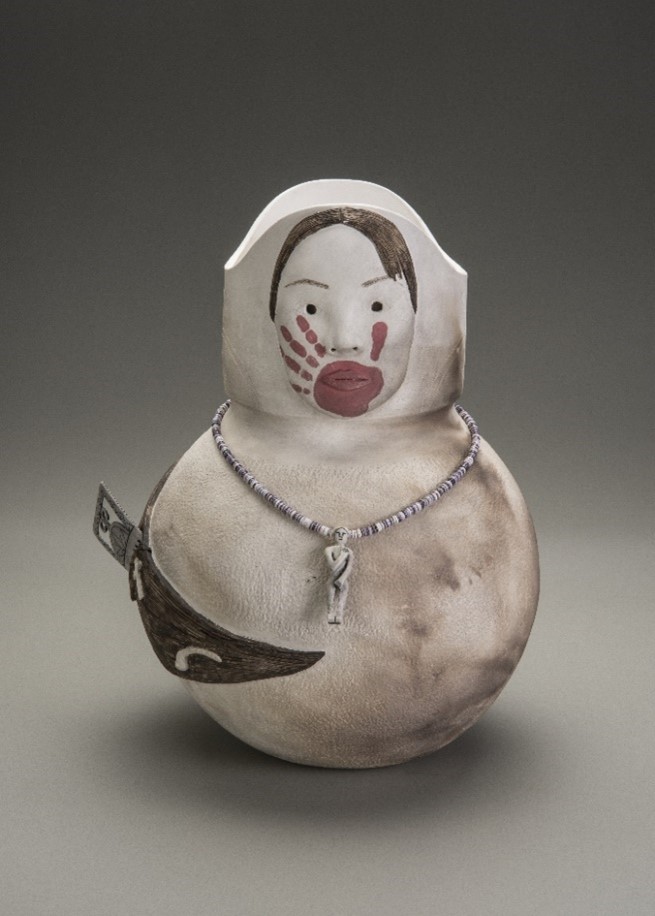
Katsitsionni Fox
Mohawk, Bear Clan, born 1968
Hayden Haynes
Seneca, Deer Clan, born 1983
Eniethiwisentá:ko (We Will Unburden Her), 2023
Smoke-fired clay pottery with underglaze, moose antler, whitetail deer antler, and wampum beads
Thelma M. Knapp Fund, 2024.1
This work is a collaboration between artists Katsitsionni Fox (pronounced ga-jeet-junie) and Hayden Haynes. The red hand across a woman’s mouth symbolizes Missing and Murdered Indigenous Women (MMIW)—a movement to bring awareness to the shockingly high rates of assault and murder of Indigenous women—and stands for their unheard voices. Ceramic artist Fox describes how she’s “thinking all the way back to creation” when she makes pots. The vessel’s rounded shape and night sky painted on the interior reference women’s role as life-givers and their connection to the Creation Story of Sky Woman, who created the earth on the back of a turtle.
In Haudenosaunee culture, the practice of combing another person’s hair with an antler comb is tied to transformation and cleansing. Eniethiwisentá:ko (We Will Unburden Her) declares to bring healing to the woman by liberating her from negative influences on Indigenous cultures, referenced by the items in her hair: a war club, cross, scissors, Playboy bunny, and cell phone.
Haynes, who carved the comb and pendant, describes, “Today, our communities continue to put the pieces back by learning, practicing, and sharing ancestral practices like clay pottery and antler carving. But at the same time, the continuation of harm and oppression of our Indigenous women is still happening.”
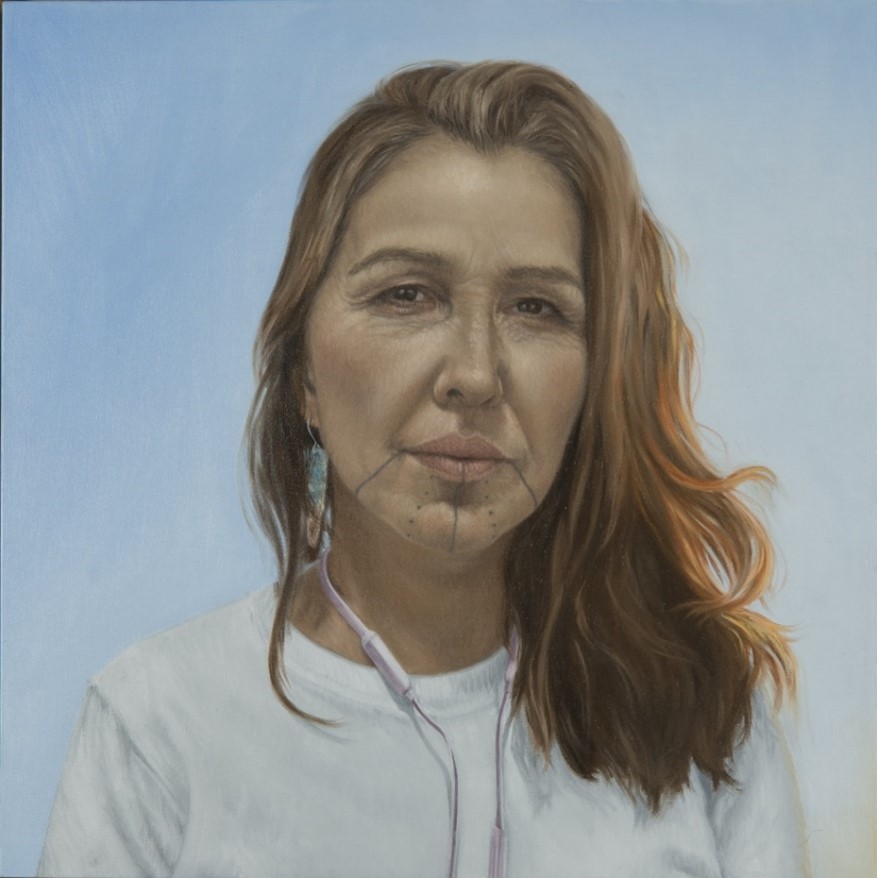
Luanne Redeye
Seneca, Hawk Clan, born 1985
Tiffany, 2018
Oil on panel
Marion Stratton Gould Fund, 2024.3
My work blends personal narrative with familial relationships and because of this intimate nature I carry memories, stories, and pictures with me of the people I depict.
Luanne Redeye
Luanne Redeye uses paint and portraiture as a form of self-determination to claim portraiture for Indigenous identities. She portrays people she knows in everyday life, including family, friends, and community members, giving her work a strong personal and emotional component. It is important to Redeye that the lives and likenesses of Indigenous people are seen.
Represented in this painting is contemporary artist Tiffany Adams (Chemehuevi Indian Tribe of Lake Havasu), who is involved in a revitalization effort for traditional Indigenous face tattoos. She created portraits of Indigenous women, adding the tattoos they had designed for themselves. Many Indigenous women lost the practice of receiving chin tattoos, which signify coming-of-age, as a result of the shame and stigma brought on by colonization.
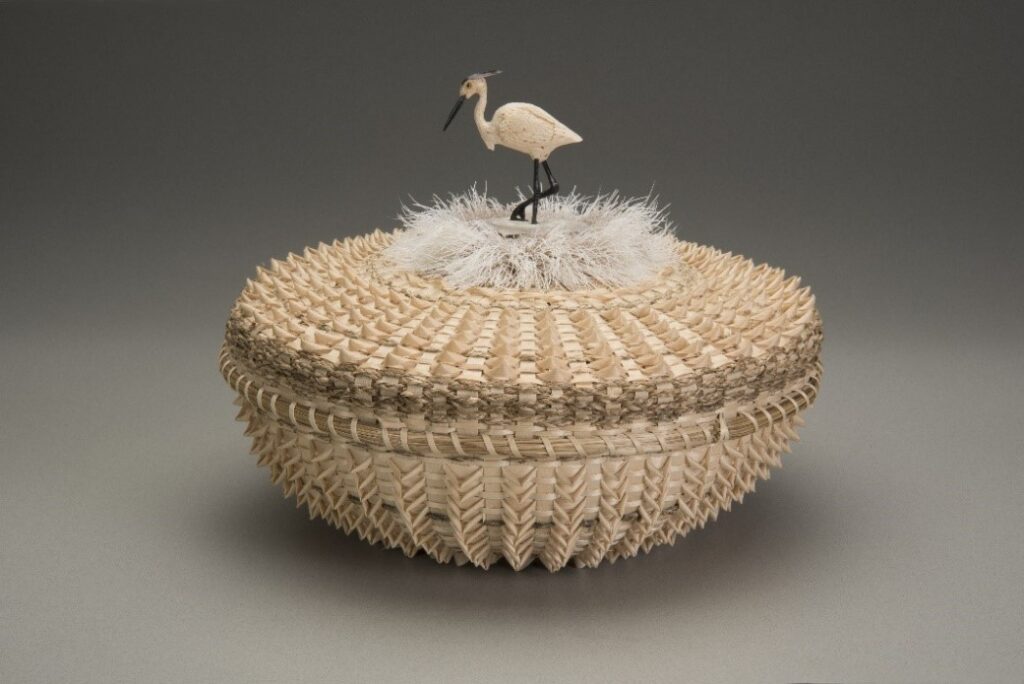
Ronni-Leigh Goeman
Onondaga, Eel Clan, born 1955
Stonehorse Goeman
Tonawanda Seneca, Hawk Clan, born 1949
The Ancient One, 2018
Black ash, sweetgrass, tufted moose hair, fossilized walrus jawbone, moose antler, and buffalo horn
Maurice R. and Maxine B. Forman Fund, 2024.4
Basket maker Ronni-Leigh Goeman and sculptor Stonehorse Goeman collaborate and innovate within the traditional Haudenosaunee art form of basketry. This basket is made of thin splints of black ash wood and braided sweetgrass. The
top embellishment is tufted moose hair and antler and bone sculpture. The process of gathering materials and preparing them for use can occupy weeks of time before weaving begins. The name of this basket, The Ancient One, refers to the longevity of the Haudenosaunee people and their traditions, symbolized by the fossilized walrus bone from which the heron is carved. In their contemporary narrative baskets, Ronni-Leigh and Stonehorse tell the stories of the Haudenosaunee, their “strengths and sorrows.”
Coming this summer
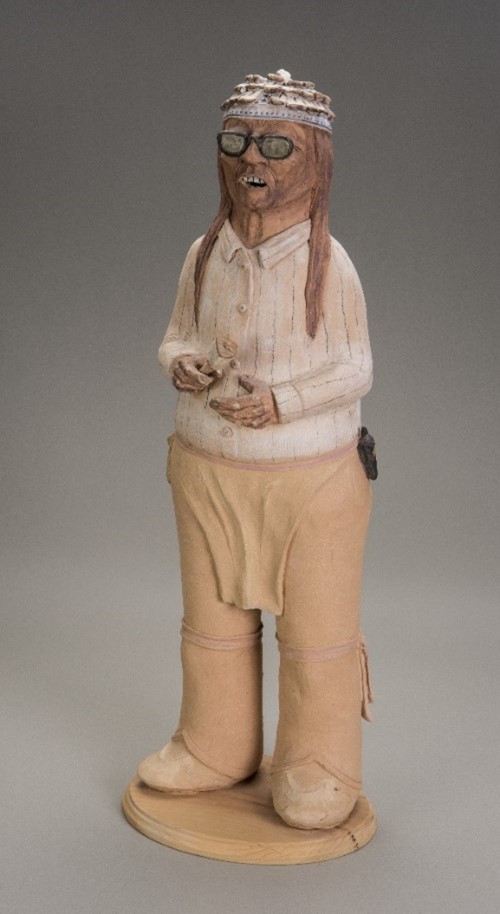
Peter B. Jones
Onondaga, Beaver Clan, born 1947
Singer with Horn Rattle, 2004
Ceramic
Thelma M. Knapp Fund, 2024.5
Peter B. Jones’s figurative sculptures celebrate the people, ideas, and worldviews of Haudenosaunee people. Singer with Horn Rattle is a twenty-first-century Onondaga man who wears sunglasses and a traditional headdress, holds a horn rattle, and has a flip phone attached to his hip. Jones has worked for decades to revive traditional Haudenosaunee ceramics techniques lost for generations due to the impacts of colonialism—clay as a material was largely replaced by metals introduced by European traders. In addition to his own artistic practice, Jones seeks to share what he has learned with the young people in his community. He operates a pottery workshop on the Cattaraugus Seneca Reservation in western New York.
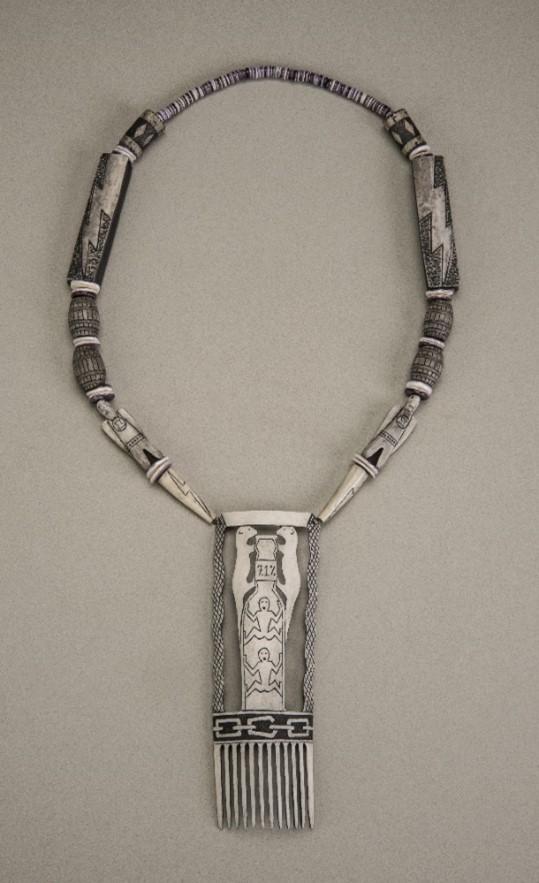
Hayden Haynes
Seneca, Deer Clan, born 1983
Self-Portrait, 2022
Whitetail deer antler, elk antler, and wampum beads
Clara and Edwin Strasenburgh Fund, 2024.2
Hayden Haynes’s artistic practice revitalizes Haudenosaunee antler carving—a centuries-old art form—in contemporary artwork that expresses his lived experience. He calls this necklace with a decorative Seneca comb pendant Self-Portrait:
I always enjoy creating pieces like this, pieces that go against what we are expected to make, things made to be aesthetically ugly, things that address the omissions of past and present stories of our people, and certainly things that highlight our fortitude.
Snakes are found in many of our Seneca stories. A couple of which refer to the thunderers which kill snakes that devour people. Much like how insatiable land speculators in the past could be a metaphor for the snake, alcohol in this piece could be used as well. It’s through truth and our culture, that we can help kill the snakes.
All of these works are part of the permanent collection and can/will be found throughout the Memorial Art Gallery.
*Photos by Andy Olenick, Fotowerks.
